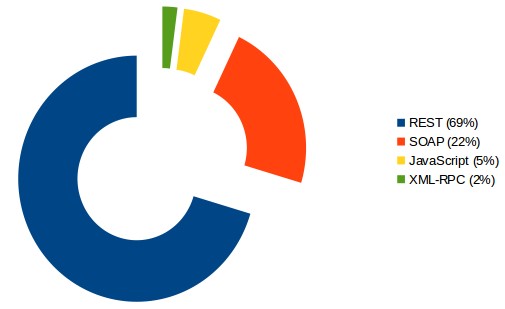What is Rest API?
REST (Representational State Transfer) is a design style, and a way to deal with interchanges that is regularly utilized as a part of the improvement of Web administrations.
The utilization of REST is regularly favored over the more heavyweight SOAP (Simple Object Access Protocol) style in light of the fact that REST does not influence as much bandwidth, which makes it a fit for using over the Web. The SOAP methodology requires composing or utilizing a given server system (to serve information) and a customer project (to demand data).
Advantages of REST over SOAP
- Developers like REST because the learning curve is less steep.
- Web Services contract first approach is more complex.
- SOAP clients for PHP and NodeJS are still not on par with Java.
- The footprint of SOAP is too big for mobile while REST footprint is small and can be used very easily as it is based on HTTP protocol.
- Parsing of JSON is less compute and memory intensive than XML.
Web APIs have encountered an exponential increment in occurrence and use in the previous couple of years. Nowadays, they're a vital tool for web designers; on the other hand, they are likewise not withstanding turning into an effective marketing tool for some kind of organizations. Most of the companies are trying to use rest api workflow or workflows for their needs, as now rest api is becoming more popular each day.
Popularity of Rest API
REST API is extensively considered as the standard protocol for the web APIs. Whereas, other protocols used for the Web APIs are less popular than REST API. Soap and JavaScript are less popular than REST.
REST API has been growing rapidly since 2005. Developers rely on this API as it is easy to understand than the rest. Growth and usage rate of REST API is greater than others. There are various graphs available on different sites that show the growth rate of REST API from 2005 to 2013 is greater than any other API.
On the off chance that one thing has increased wide response; it's the standards of RESTful. These were initially presented by Roy Fielding in Chapter 5 of his paper on network-based software architectures.
One of the reasons for the popularity of REST API is that it is user-friendly and it is easy to understand for the developers to code on it. Developing REST API is easier than the rest when your actual focus is on data.
In one of the largest independent and publicly available directories for APIs, the ProgrammableWeb, the share of Internet APIs by technology in March 2014 is:

REST (69%), SOAP (18%), JavaScript (5%), and XML-RPC (2%).
Why REST APIs are being adopted so fast? There are several reasons for that.
For instance, since REST utilizes standard HTTP asks for, our data validation and address verification APIs are simple for designers to comprehend and execute. What's more, RESTful architectures make it simple to give output in more adaptable data formats like JSON.
The key standards of REST include isolating your API into valid assets. These assets are controlled utilizing HTTP requests for where the technique (GET, POST, PUT, PATCH, and DELETE) has particular means.
There are some best practices that can help you to design a RESTful API:
- Make use of nouns instead of using verbs. Make use of nouns for every resource i.e. GET, POST, PUT, DELETE.
- Do not use GET method to change the state, You can use PUT, POST, and DELETE methods in place of using GET method.
- Use only plural nouns instead of using mixture of singular and plural nouns.
- You can use sub-resources if two resources are related to each other.
- Client and Server, both should know that which format can be used for the communication. The format needs to be specified in the HTTP-header.
Testing RESTful API:
There are two primary use situations when you to test rest api online:
After developing you need to send a RESTful Web service to ensure that it is working according to your needs: that it is available in consistence with the specification and that it is responding accordingly.
While development of an application that is addressing a RESTful Web Service, for this situation it is useful to examine the access to the service and the information that is required before you start developing. While developing, you might need to call the Web service from outside your application. It will be helpful for you to find the errors when your application is showing the unexpected results while there are no logical errors detected in your code and you think that the restricted access is the connection with the Web service.